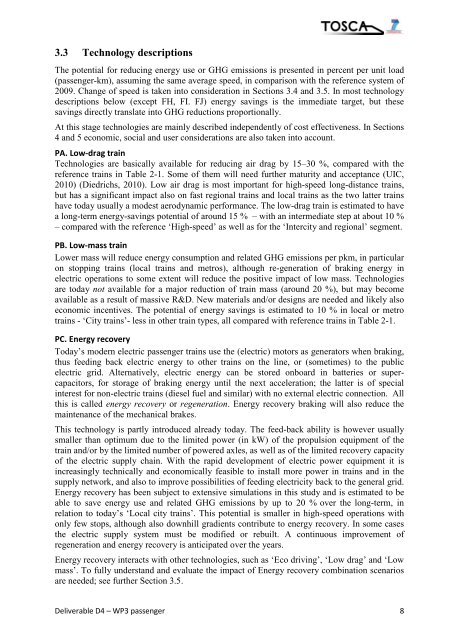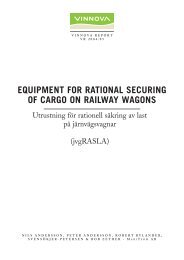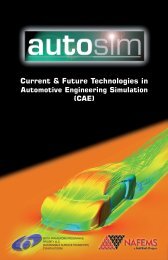WP3: Rail Passenger Transport - TOSCA Project
WP3: Rail Passenger Transport - TOSCA Project
WP3: Rail Passenger Transport - TOSCA Project
Create successful ePaper yourself
Turn your PDF publications into a flip-book with our unique Google optimized e-Paper software.
3.3 Technology descriptions<br />
The potential for reducing energy use or GHG emissions is presented in percent per unit load<br />
(passenger-km), assuming the same average speed, in comparison with the reference system of<br />
2009. Change of speed is taken into consideration in Sections 3.4 and 3.5. In most technology<br />
descriptions below (except FH, FI. FJ) energy savings is the immediate target, but these<br />
savings directly translate into GHG reductions proportionally.<br />
At this stage technologies are mainly described independently of cost effectiveness. In Sections<br />
4 and 5 economic, social and user considerations are also taken into account.<br />
PA. Low-drag train<br />
Technologies are basically available for reducing air drag by 15–30 %, compared with the<br />
reference trains in Table 2-1. Some of them will need further maturity and acceptance (UIC,<br />
2010) (Diedrichs, 2010). Low air drag is most important for high-speed long-distance trains,<br />
but has a significant impact also on fast regional trains and local trains as the two latter trains<br />
have today usually a modest aerodynamic performance. The low-drag train is estimated to have<br />
a long-term energy-savings potential of around 15 % – with an intermediate step at about 10 %<br />
– compared with the reference ‘High-speed’ as well as for the ‘Intercity and regional’ segment.<br />
PB. Low-mass train<br />
Lower mass will reduce energy consumption and related GHG emissions per pkm, in particular<br />
on stopping trains (local trains and metros), although re-generation of braking energy in<br />
electric operations to some extent will reduce the positive impact of low mass. Technologies<br />
are today not available for a major reduction of train mass (around 20 %), but may become<br />
available as a result of massive R&D. New materials and/or designs are needed and likely also<br />
economic incentives. The potential of energy savings is estimated to 10 % in local or metro<br />
trains - ‘City trains’- less in other train types, all compared with reference trains in Table 2-1.<br />
PC. Energy recovery<br />
Today’s modern electric passenger trains use the (electric) motors as generators when braking,<br />
thus feeding back electric energy to other trains on the line, or (sometimes) to the public<br />
electric grid. Alternatively, electric energy can be stored onboard in batteries or supercapacitors,<br />
for storage of braking energy until the next acceleration; the latter is of special<br />
interest for non-electric trains (diesel fuel and similar) with no external electric connection. All<br />
this is called energy recovery or regeneration. Energy recovery braking will also reduce the<br />
maintenance of the mechanical brakes.<br />
This technology is partly introduced already today. The feed-back ability is however usually<br />
smaller than optimum due to the limited power (in kW) of the propulsion equipment of the<br />
train and/or by the limited number of powered axles, as well as of the limited recovery capacity<br />
of the electric supply chain. With the rapid development of electric power equipment it is<br />
increasingly technically and economically feasible to install more power in trains and in the<br />
supply network, and also to improve possibilities of feeding electricity back to the general grid.<br />
Energy recovery has been subject to extensive simulations in this study and is estimated to be<br />
able to save energy use and related GHG emissions by up to 20 % over the long-term, in<br />
relation to today’s ‘Local city trains’. This potential is smaller in high-speed operations with<br />
only few stops, although also downhill gradients contribute to energy recovery. In some cases<br />
the electric supply system must be modified or rebuilt. A continuous improvement of<br />
regeneration and energy recovery is anticipated over the years.<br />
Energy recovery interacts with other technologies, such as ‘Eco driving’, ‘Low drag’ and ‘Low<br />
mass’. To fully understand and evaluate the impact of Energy recovery combination scenarios<br />
are needed; see further Section 3.5.<br />
Deliverable D4 – <strong>WP3</strong> passenger 8
















